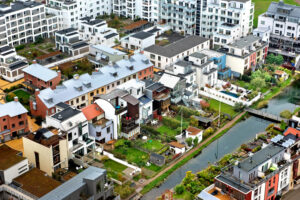Segregation, alienation, and the pursuit of social sustainability have put suburbia and large-scale residential areas in focus for urban development projects. The renewal of city districts aims to improve a residential area or a district through physical renovation with a social perspective.
The need for rearmament as a motor
In Sweden, approximately 650,000 homes within apartment buildings need to be renovated and transformed to become more energy efficient. Many of these properties are located in areas that were built around the same period and, in addition to often having a bad reputation and low attractiveness, they have an extensive need for technical maintenance and renovation. However, financing plays a crucial role in determining how these renewals are carried out, as there is often limited economic space for increased rents among residents.
Urban renewal and renovation efforts must consider all three dimensions of sustainable development, that is, social, environmental, and economic dimensions. Real estate technical improvements should be implemented with a social perspective, which includes involving those who live and operate in the area to be upgraded.

Image by Aline Lessner/imagebank.sweden.se
There is a growing awareness that renewal processes should begin with the residents themselves, tapping into their knowledge and understanding of how the area functions. It is also important to combine physical renewal with efforts to strengthen the area’s identity and foster a sense of togetherness. Establishing trust and cooperation among all involved parties is crucial for the success of these efforts.
In addition, these renovation and renewal processes should have in mind not to change altogether the population composition, but to improve the living conditions for those living in the area. The measures implemented should be tailored to their needs and economic circumstances, ensuring that the community remains accessible and inclusive.
Swedish public housing companies have decades of experience when it comes to achieving socially sustainable regeneration in socio-economically disadvantaged neighborhoods. Many take great consideration of social aspects in renovation and renewal efforts, working with social procurements, operating and supporting different social and cultural activities for residents, and collaborating with multiple stakeholders.